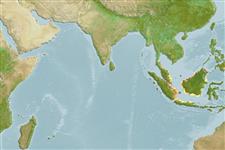>
Atheriniformes (Silversides) >
Phallostethidae (Priapiumfishes)
Etymology: Phallostethus: Greek, phallos = penis + Greek, stetho, stethion = brest; literal = to prick a little breast (Ref. 45335).
Environment: milieu / climate zone / depth range / distribution range
Ecologia
marinhas; estuarina. Tropical
Western Pacific: Borneo.
Tamanho / Peso / Idade
Maturity: Lm ? range ? - ? cm
Max length : 2.7 cm SL macho/indeterminado; (Ref. 12769); 2.8 cm SL (female)
Descrição breve
Morfologia | Morfometria
Differs from all congeners by having the following characters: second ctenactinium with eight serrae in adult males; 28 caudal vertebrae with no sexual dimorphism in the number of precaudal vertebrae; 28 or more teeth on paradentary; all males are sinistral (Ref. 90869).
Fertilization is internal and eggs are attached to the substrate via adhesive filaments (Ref. 43413).
Life cycle and mating behavior
Maturidade | Reprodução | Desova | Ovos | Fecundidade | Larvas
Pelvic fins in males are modified to form part of a complex thoracic clasping organ (Ref. 205).
Parenti, L.R., 1996. Phylogenetic systematics and biogeography of phallostethid fishes (Atherinomorpha, Phallostethidae) of northwestern Borneo, with description of a new species. Copeia 1996(3):703-712. (Ref. 12769)
Categoria na Lista Vermelha da IUCN (Ref. 130435)
Ameaça para o homem
Harmless
Utilização humana
Mais informação
Idade/TamanhoCrescimentoComprimento-pesoComprimento-comprimentoFrequência de comprimentoMorfometriaMorfologiaLarvasDinâmica larvarRecrutamentoAbundânciaBRUVS
ReferênciasAquaculturaPerfil para aquaculturaEstirpesGenéticaElectrophoresesHereditariedadeDoençasProcessamentoNutrientsMass conversion
ColaboradoresFotografiasStamps, Coins Misc.SonsCiguateraVelocidadeTipo de nataçãoÁrea branquialOutras referênciasCérebrosVisão
Ferramentas
Relatórios especiais
Descarregue XML
Fontes da internet
Estimates based on models
Preferred temperature (Ref.
123201): 28.2 - 29.1, mean 28.7 °C (based on 198 cells).
Phylogenetic diversity index (Ref.
82804): PD
50 = 0.6250 [Uniqueness, from 0.5 = low to 2.0 = high].
Bayesian length-weight: a=0.00389 (0.00180 - 0.00842), b=3.12 (2.94 - 3.30), in cm total length, based on all LWR estimates for this body shape (Ref.
93245).
Nível Trófico (Ref.
69278): 3.1 ±0.3 se; based on size and trophs of closest relatives
Fishing Vulnerability (Ref.
59153): Low vulnerability (10 of 100).
